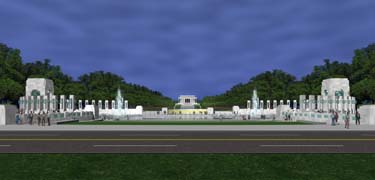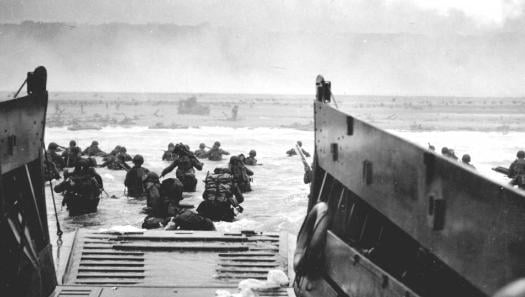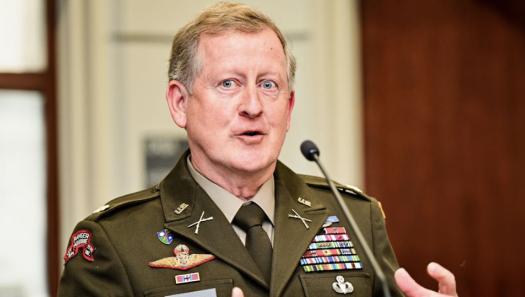Military & Veterans News
Vet News: America Remembers
Master Sgt. Bob Haskell, National Guard


WASHINGTON, June 1, 2004 -- Three men who are pushing 80 or who have already passed that milestone of longevity and who were soldierly trim on Memorial Day weekend represented the way that young men served and fought in 19 National Guard infantry divisions during World War II.
They were present and accounted for, with tens of thousands of comrades in arms from their youth and other members of the “greatest generation,” during the dedication of the National World War II Memorial on sunny, somber May 29.
David Mealor, 81, of Newnan, Ga., recalled enlisting in the Guard’s 31st Division in November 1940 after being told he would be able to go home after training for a year and that he would not be drafted.
Pearl Harbor changed everything. Mealor served in the Pacific, in New Guinea, with his field artillery battalion for 10 months before “jungle rot” forced him to return stateside where he was assigned to a Signal Corps outfit.
Paul Malone, 80, from Sullivan, Ind., was drafted in March 1943 and wound up in the Guard’s “Texas Division,” the 36th, in Italy. He trained to be a sniper. He took part in the breakout at Anzio and the liberation of Rome on June 4, 1944. He was discharged as a private first class in November 1945, rejoined the Army in 1947 and retired as a sergeant first class in 1966.
Robert Dornblaser, 78, of Lander, Wyo., volunteered for duty when he was 17 and joined the 32nd Division as a replacement Soldier in early 1944. He served for about eight months in New Guinea and the Philippines. He still carries shrapnel close to his lung from a wound in his back in New Guinea which earned him a Purple Heart. He recovered in time to land on Leyte Island during the Philippines invasion and was sent home after getting blown out of his foxhole.
It’s not as if the World War II Veterans have been forgotten for the past 60 years. But the nation as a whole has never turned out to say “thank you” as it did to that entire generation during Memorial Day weekend. That’s what dedicating the memorial of bronze and granite on its 7.4-acre site on the National Mall accomplished for those who have lived to see it.
“It is a fitting tribute, open and expansive like America itself, grand and enduring like the achievements we honor,” said President Bush. “They gave the best years of their lives to the greatest mission their country ever accepted.”
“More young people have thanked me than have other older people,” Dornblaser said. “It makes you feel proud of what you did. I congratulate them for feeling like they do and for understanding.”
Retired Mississippi Congressman G.V. “Sonny” Montgomery, known as “Mr. National Guard,” was the first of many members of Congress credited with laboring during the past 17 years to create the National World War II Memorial.
It is as much a tribute to members of the National Guard’s divisions as it is to other Soldiers, Sailors, Marines, Airmen and those who served in the Coast Guard and Merchant Marine.
Why?
Had it not been for the National Guard, this country would not have had the Army it needed to go to war after the Japanese attacked Pearl Harbor on Dec. 7, 1941, and after the United States declared war against Germany and Italy four days later.
Here’s what National Guard Bureau historians have to say about the way things were more than six decades ago.
The first of 300,034 National Guard Soldiers reported for active duty, “for one year of training,” in September 1940. The Guard’s 18 infantry divisions, 80 separate regiments, and 29 Army Air Force flying squadrons doubled the size of the U.S. Army.
“The entire National Guard was already on active duty when the United States entered World War II,” according to a National Guard Bureau fact sheet.
In all, 19 Guard divisions took part, and the nation’s first peacetime conscription put another million men in Army uniforms. Congress extended the term of service for mobilized Guardsmen and draftees by one year in August 1941.
California’s 251st Coast Artillery had already been stationed in Hawaii for a year on Dec. 7, 1941. Those Soldiers took part in the defense of Oahu as did the Guardsmen in Hawaii’s 298th Infantry Regiment.
When Japanese troops invaded the Philippine Islands three days later, U.S. troops there included the New Mexico Guard’s 200th Coast Artillery and two tank battalions made up of National Guard units from various states. Half of those men died as prisoners of the Japanese.
North Dakota’s 164th Infantry, sent to reinforce the Marines on Guadalcanal in October 1942, became the first U.S. Army regiment to fight offensively during World War II. They were soon joined by their sister Guard infantry regiments, the 132nd from Illinois and the 182nd from Massachusetts, in the new Americal Division.
The Guard’s 32nd and 41st Infantry Divisions became the first Army divisions to fight and defeat the Japanese, in late 1942 and early 1943.
The 34th was the first Army Division to sail overseas, and, at North Africa, it became one of the first two U.S. infantry divisions to fight in the European theater. The 34th spent more actual days in combat than any other U.S. Army division.
National Guard flying squadrons were among the first to reach the combat zone. The observation squadrons, the 111th from Texas, the 122nd from Louisiana, and the 154th from Arkansas arrived in North Africa in the fall of 1942.
In July 1944, Michigan’s 107th Tactical Reconnaissance Group became the first Army Air Force unit to operate from the European continent after it had flown missions before the June 6 landings at Normandy.
Five Guard divisions were the first in the Army to deploy overseas, all in 1942. They were the 34th, Americal, 27th, 41st and 32nd.
Three Guard divisions were the first of the Army’s divisions to enter combat - the 32nd in New Guinea, Americal at Guadalcanal, and 34th at North Africa.
Four Guard divisions were among the 10 Army divisions to suffer the most casualties. The 29th was fourth with 20,327 casualties; the 45th was sixth with 18,521; the 30th was eighth with 16,892; and the 36th was ninth with 16,828.
Guardsmen received 20 of the 464 Medals of Honor bestowed on World War II service members.
Those who did not live to savor the fruits of their labors or to see their memorial were also remembered in Washington in late May. One was an infantry medic who was killed about two months before the fighting ended.
“Father killed in Philippines June 19, 1945. Buried in military cemetery @ Manila,” wrote Sandra Hayes about her father, Sim Ellis of Alabama, in a message posted on a bulletin board for the 31st Division in the Reunion Tent.
But the Veterans who have lived to see their memorial like it and wonder what took so long to get it.
“It’s very impressive. I don’t know why anybody would say anything detrimental about it,” said David Mealor who was accompanied by two of his sons and a grandson. Another grandson, Thomas Mealor-Russell, is a corporal in the Florida Army National Guard, they related.
“I think it’s great. But 59 years is a long time to wait,” said Paul Malone who still believes that what the 36th accomplished in Italy was overshadowed by the landings at Normandy, France.
“We liberated Rome on June 4, 1944. D-Day was two days later. D-Day. That’s all you hear about is D-Day,” he added. “The whole year we spent in Italy got by everybody.”
Now, American’s everywhere are remembering what Paul Malone and David Mealor and Robert Dornblaser and more than 16 million others like them did during World War II thanks to the new memorial in Washington.
SOURCE: VNIS


